As a young child, one of my clients learnt to dissociate when her parents were arguing. When I first started treating her, and did not understand the dissociation model I now work with, we both thought the sessions were productive because she consistently reported a warm, floating quality. A space where her body did not constrain her.
However, her symptoms never changed.
It took me over a year to work out what was going on. Her healing started when she made friends with her ‘boring’ body.
Most people dissociate most of the time, and the pleasant, dream like quality in dissociation is often confusing. Dissociation is surprisingly common and people often frequently enjoy being dissociated. Being in a body is hard work. It is a constant negotiation to clearly map the size, shape and weight of the body.
Many people can misinterpret the dreamy floaty quality of dissociation as an expansive, spiritual, healing experience. I have treated many long term meditators, yoga teachers and spiritual searchers. The relationship to the body offered through an understanding of trauma and dissociation has been surprising and beneficial for many of them. It is essential to not be too quick to let go of the body.
Before we can transcend our body we have to have a body.
For most of us there is a lifetime of work involved in exploring our flesh.
Deepening into our bodies is the necessary step that allows us to widen our perceptual horizons and drop into deeper tides and stillness. It is true that the sense of the body can become much more diffuse and fade into the background. However the form is never lost, as in dissociation, and is always available for our return.
A simple tool for health is practicing mapping out and connecting to your size, shape and weight as accurately as possible.
The bigger the gap between our real body and our virtual body (the perceived map we make of our body) the greater our pain, anxiety and depression.
Awareness Exercise: Exploring how you map your body
1 Start out by sitting or lying quietly
Take some time to slow down and explore your sense of your body.
2 Orient to the size shape and weight of your body.
Deepen your awareness to really focus on simple body sensations – the size, shape and weight.
Notice the bits that are hidden or missing or hard to contact.
Try noticing if your perception of both your legs is the same. It is not uncommon for one leg to be quite different. Is one side hazy or heavy or floating or sinking?
Do you have small far way feet or big hands? Can you feel aliveness inside your belly?
Compare top to bottom, left to right, middle to periphery.
3 ‘How is your brain mapping out your body?’
Use a light, responsive approach here. The goal is develop awareness of present time sensations. Try to find simple, words. Slow down too many stories, encourage differentiation of sensations.
Be curious: ‘So thats interesting, my brain is mapping out my left leg differently’ Try to just notice what you are feeling for a bit. Try not to want it to change.
For more support with grounding and embodiment, you can download my free ebook here.
 Thanks, Steve
Thanks, Steve
Upcoming events:
Engaging the Body: exploring movement and awareness to change pain workshop ~ November 1st
Intro to Relational Touch ~ Nov 3rd
Trauma Releasing Exercises intro ~ Nov 14th.


